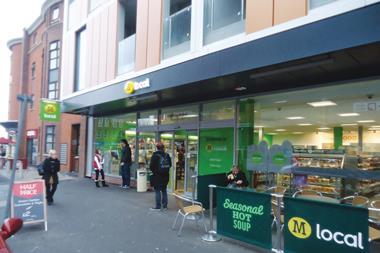Morrisons today reported a 2.1% fall in like-for-likes for the third quarter. Retail Week takes a look at what went wrong and how the retailer can steady the ship.
Morrisons’ poor trading in the last quarter came as little surprise this morning after market share figures from Kantar Worldpanel and Nielsen had already showed momentum has slowed in what is becoming a poor year for the grocer.
Morrisons’ problems are plentiful and range from worries over consumer perception to quite simply the products it is selling.
The company has blamed the macroeconomic environment and, with wider market volumes declining, this is a perfectly valid argument for underperformance.
However, conditions are the same throughout the industry and the on song performance of both Asda and Sainsbury’s in particular will have dismayed those in Bradford. Morrisons’ continued like-for-like decline may also reflect Tesco’s £1bn turnaround beginning to take effect.
Marketing has been a key problem area for Morrisons. Its Great British Price Crunch promotion has not gained traction with customers and its Fuel Saver deal – while a clever mechanic for those who understand it – is arguably too convoluted when compared to promotions such as Sainsbury’s Brand Match.
In store, the refresh of 10,000 of its own brand products does not appear to have caught consumers imagination. Morrisons needs to persuade shoppers to put both its value M Savers range and premium products in the same basket to ultimately up spend and returns on own label. Morale on the shop floor is unlikely to be high with company performance low and sources within the retailer claim that some stores are understaffed and store standards have slipped.
The departure of commercial director Richard Hodgson shortly before Christmas will come as a blow at such a vital time for the retailer. Chief executive Dalton Philips - who has this year not only lost Hodgson, but also marketing director Richard Lancaster to Poundland and will next year wave goodbye to highly regarded chief financial officer Richard Pennycook - will be feeling increasingly exposed at the head of an underperforming business.
However, Philips cannot be criticised for not being proactive – he’s introduced a new store format, kicked off Morrisons’ ecommerce arm, acquired Kiddicare and a stake in Fresh Direct, launched a convenience business, overhauled the business’ IT systems and set up a fledgling clothing business. But it can be argued he has not been swift enough in implementing any of these initiatives.
Verdict Research analyst Cliona Lynch says: “The rollout of fresh format stores is driving towards its goal of 100 by March 2013. With sales uplift of 4-6% in refurbished stores it is imperative that the pace of roll-out quickens to mitigate against the decline in sales in older stores. The retailer’s convenience format M Local is on course to reach 20 stores by March 2013 but with seven currently trading there is a lot for the retailer to do.”
New convenience boss Gordon Mowat will be a key figure in the coming year.
Sir Ken Morrisons’ argument that the Fresh Format is moving Morrisons too far upmarket is arguably flawed. Bringing the store environment on an even par or slightly ahead of its rivals is unlikely to send shoppers dashing down to Iceland or Aldi scared of some nice lighting and a good range of fresh food. More likely, the range of products on the shelves are not what shopeprs want to buy.
Lynch believes that 2013 could be a crunch year for the retailer and that this time next year the numbers could tell a different story. She adds: “This expansion, coupled with improved marketing communication, should help Morrisons to reverse its fortunes in 2013 and realise the potential which its strategic direction offers.”
Philips will be keen to put his foot on the accelerator, drive forward performance in the crucial Christmas period and prevent an ugly crash into a profit warning in January.

























No comments yet